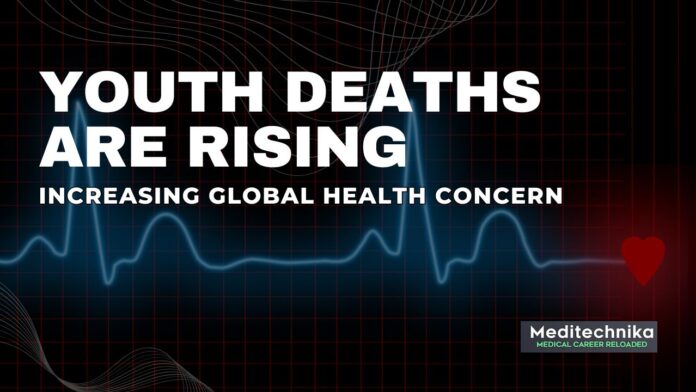Global Health Study – Youth Deaths Are Rising as the World Gets Healthier
In a surprising study, the latest Global Burden of Disease (GBD) 2023 Study, presented at the World Health Summit in Berlin, uncovers a contradiction shaping the future of global health: While people around the world are living longer than ever, young people are dying more, and from causes that we could have prevented.
A Healthier World – But Not for Everyone
One of the world’s most comprehensive health studies, led by the Institute for Health Metrics and Evaluation (IHME) at the University of Washington, analyzed data from 204 countries covering 375 diseases and 88 risk factors.
Here is the good news first: The global mortality rate has dropped by 67% since 1950, and life expectancy has returned to pre-pandemic levels: 76.3 years for women and 71.5 years for men.
But beneath these impressive averages lies a disturbing truth:
Deaths among adolescents and young adults are increasing rapidly, mainly in high-income regions like North America and Eastern Europe.
Global Health Study Reveals a Silent Surge in Youth Deaths
Between 2011 and 2023, deaths among people aged 20 to 39 rose sharply – due to drug overdoses, suicides, and alcohol abuse.
Even younger groups (ages 5–19) saw rising death rates in some parts of the world, particularly North America and the Caribbean.
Meanwhile, infant deaths – once the world’s most significant concern – have dropped thanks to better nutrition, vaccines, and healthcare systems, particularly in East Asia.
So, the global health narrative is shifting from saving newborns to saving young adults who are struggling more than adults with modern lifestyle diseases and mental health crises.
From Infections to Non-Communicable Diseases (NCDs)
Gone are the days when infectious diseases were a major cause of death. Now, the non-communicable diseases (NCDs) are chronic conditions like heart disease, stroke, diabetes, and kidney failure, which cause almost two-thirds of all deaths worldwide.
COVID-19, which was in the main headlines in 2020, became the 20th leading cause of death in 2023. But the diseases due to lifestyle changes and aging are taking the spotlight now.
Top Global Killers (2023)
- Ischemic heart disease
- Stroke
- Chronic obstructive pulmonary disease (COPD)
- Lower respiratory infections
- Neonatal disorders
Surprisingly, deaths due to heart attacks and strokes have reduced a lot since 1990. But still, diabetes, Alzheimer’s, and kidney diseases are increasing rapidly, which is a warning sign.
The Inequality Gap Persists
While people in high-income countries might live up to 83years, some people in sub-Saharan Africa still face an average life expectancy of just 62years.
Even worse, women in sub-Saharan Africa aged 15-29 are dying 61% more often than previously estimated, mostly from maternal complications, road injuries, and infections. These statistics depict a painful truth – where you live still can determine how long you can live.
Global Health Study: What’s Driving the World’s Health Burden?
The GBD study also found that almost half of the deaths and disabilities could have been prevented by changeable risk factors, including:
- High blood pressure
- Air pollution
- Smoking
- High blood sugar
- Obesity (high BMI)
- High cholesterol
- Poor kidney function
- Malnutrition
- Lead exposure
- Unsafe water and sanitation
High BMI, drug use, and elevated blood sugar showed the steepest increases between 2010 and 2023 – showing how modern lifestyles are taking a silent but powerful toll.
Global Health Study Highlights the Climate Connection
Risks due to environmental changes have become harder to ignore.
Air pollution remains the second-largest health risk, especially in South Asia and sub-Saharan Africa. Rising temperatures are increasing health-related illnesses and worsening food insecurity, and increasing the migration rate.
The Mental Health Crisis
As mental health disorders are rising, anxiety-related disorders rose up to 63% while depression increased to 26% over the past decade.
Researchers say that violence, abuse, and social isolation are preventable drivers and also warn that mental health must become a core part of global health strategies.
Researchers point to violence, abuse, and social isolation as key preventable drivers – and warn that mental health must become a core part of global health strategies, not an afterthought.
The Shifting Focus: From Survival to Well-being
For decades, global health efforts have focused on reducing child mortality.
Now, experts say that it’s time to expand priorities to include adolescents and young adults, whose health outcomes are worsening in ways we did not understand before.
Dr. Christopher Murray, Director of IHME, calls this trend “a wake-up call for governments and health leaders to act swiftly and strategically.”
If we don’t invest more in prevention, mental health, and making sure everyone can get care, the progress we’ve made in saving lives could start to fall apart. This is especially true in countries that are losing international health aid.
The Bottom Line
The world is living longer – but not necessarily better.
Many infectious diseases are in human control. However, contemporary issues such as obesity, stress, pollution and inequality have altered the global risk profile of diseases.
The Challenge Ahead?
To ensure that longer lives also mean healthier, happier ones – for every generation, not just the old.






